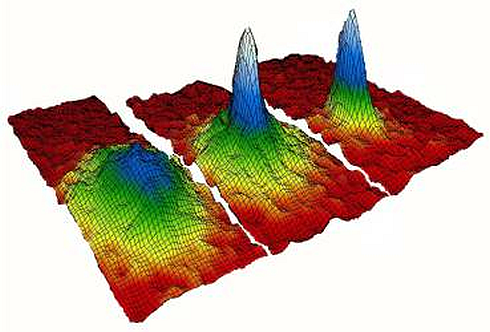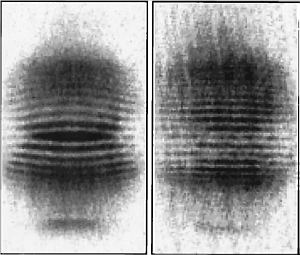i. What are the properties of a Bose Einstein Condensate?
The most obvious property of a BEC is that a large fraction of its particles occupy the same, namely the lowest, energy state. In atomic condensates this can be confirmed by measuring the velocity distribution of the atoms in the gas.

The above figure shows the result of such a measurement. In the left plot, no Bose Einstein Condensation took place. One can see that the energy distribution of the atoms is given by the Bose Einstein statistics. In the middle plot, the conditions for condensation were hardly achieved. One can still clearly see the statistically distributed atoms; but on top of this distribution a overpopulation of the ground state can also be identified, expressed by the sharp blue peak. In the picture to the right, the conditions for condensation where fulfilled very good (the temperature was lower than required), so that hardly any statistically distributed atoms can be seen. Instead one can observe a high concentration of atoms in the ground state.
Another important property is coherence. Because of this property it is possible to treat the whole condensate as one big matter wave in analogy to a light wave produced by a laser. With this matter waves we can perform similar experiments as with light waves. For example it is possible to led two condensates to interfere with each other.

When we overlap two clouds of Bose condensed atoms their densities do not simply sum up, but they interfere with each other creating a spatial density profile with periodically arranged maxima and minima in analogy to two interfering light beams which produce a similar scheme on a screen.
An important effect, that can observed in Bose Einstein Condensates, is quantum mechanical tunneling. It means that a small fraction of the condensate can overcome a barrier that could not be overcome by a classical particle. A fraction of the condensate "tunnels" through this barrier.
This property gives rise to other quantum mechanical effects like the Josephson-Effect. A Josephson-Effect always occurs when two macroscopic quantum objects are separated by a “weak link”. A “weak link” is a barrier that is high enough, that no particle of the two condensates could cross it in the classical picture but low enough, that a fraction of the condensate can tunnel through it in the quantum mechanical picture.
The Josephson-Effect might become very important in the future. Quantum Computers work on a absolutely different basis than our normal computers. Due to this they are incredibly fast in some applications. For example a future quantum computer should be able to hack the strongest encryptions, available today, within a few seconds. Quantum Computers don't use, like normal computers, bits as elementary units instead they use quantum bits, also called qubits for their calculations. Due to the fact that a BEC is a macroscopic quantum object it should be possible to construct a robust qubit out of it, eventually by utilizing the Josephson-Effect.
Todays quantum computers have to be cooled down slightly above the absolute zero point. Because of this, operation of quantum computers is very elaborate, and a home use unthinkable at the moment. The quasi particles of spin waves, in a crystal, the magnons, are also able to undergo a Bose Einstein Condensation. The advantage of this system is that Bose Einstein Condensation can take place even at room temperature.
Probably the reader is not aware of all the terms that were used in the last passage; they will be explained in the following. The next chapter treats

